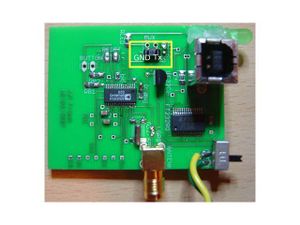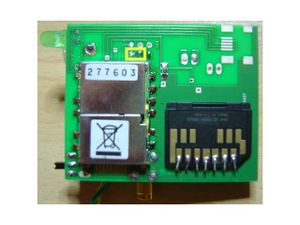Difference between revisions of "GPS"
From ArmadeusWiki
(→RS232 modules) |
(→Usage) |
||
| Line 18: | Line 18: | ||
==Usage== | ==Usage== | ||
| + | === APF51 === | ||
| + | TODO | ||
=== APF27 Wireless (APW)=== | === APF27 Wireless (APW)=== | ||
* Be sure to have correctly choosen the GPS option [[Wireless_extension_board#Linux_configuration|while configuring you Linux kernel for the APW]]. This will autoselect and activate corresponding serial port. Reflash your Linux kernel. | * Be sure to have correctly choosen the GPS option [[Wireless_extension_board#Linux_configuration|while configuring you Linux kernel for the APW]]. This will autoselect and activate corresponding serial port. Reflash your Linux kernel. | ||
Revision as of 09:22, 28 June 2011
This page will summarize informations to connect GPS modules to your Armadeus board.
Contents
Introduction
GPS stands for Global Positioning System and is intended to allow one to knows its localization on Earth quite accuratly. See this Wikipedia article for more informations. GPS receivers are generally driven through a low speed RS232 bus or USB.
RS232 modules
The following RS232 receivers were successfully tested:
- the GPS receiver of the APF27 Wireless extension board (uBlox)
- the GPS receiver of the Projet Aurore association. This autonomous receiver uses a standard NMEA GPS module that can be connected to the 3,3V RS232 port of your APF9328. All you need to do is to get the GND and TX signals out of this module and connect is to your GND and RX signals of your APF:
USB modules
These modules are mostly serial one with a RS232 <-> USB converter. None were tested yet.
Usage
APF51
TODO
APF27 Wireless (APW)
- Be sure to have correctly choosen the GPS option while configuring you Linux kernel for the APW. This will autoselect and activate corresponding serial port. Reflash your Linux kernel.
- Be sure that J3 jumper (near SIM card socket) is plugged in
- Configure GPS serial port (4 for Linux == UART5 for i.MX) of your APF27 (raw, no echo, 38400 bauds 8N1):
# stty -F /dev/ttySMX4 raw -echo -echoe -echok 38400
- Test it: you'll get NMEA frames:
# cat /dev/ttySMX4 $GPGSV,3,1,12,01,80,354,,02,32,070,38,04,13,037,09,09,14,146,*78 $GPRMC,164916.00,V,,,,,,,130709,,,N*7C $GPGGA,164916.00,,,,,0,00,99.99,,,,,,*6B
APF9328
- Configure Serial port 1 of your APF9328 (4800 bauds 8N1):
# stty -F /dev/ttySMX1 4800
- Power on your GPS module
- Test it: you'll get NMEA frames:
# cat /dev/ttySMX1 $GPGGA,000026.032,,,,,0,00,,,M,0.0,M,,0000*53 $GPGSA,A,1,,,,,,,,,,,,,,,*1E $GPRMC,000026.032,V,,,,,,,160406,,*2F $GPGGA,000027.032,,,,,0,00,,,M,0.0,M,,0000*52
NMEA Frames signification
- There is a small tool (under development) in target/demos/gps/ that can help you to understand how to parse some NMEA frames in your application.
- $GPGGA: Global Positioning System Fix Data
- $GPGLL: Geographic Position, Latitude/Longitude
- $GPGSA: GPS DOP and Active Satellites
- $GPGSV: GPS Satellites in View
- $GPRMB: Recommended Minimum Navigation Information
- $GPRMC: Recommended Minimum Specific GPS/TRANSIT Data
Troubleshots
- In case your Aurore GPS module is detected and then automatically removed from the USB stack when you plug it on your PC, try to uninstall brltty:
$ sudo apt-get remove brltty
Going further
- If you don't want to manually parse NMEA frames in your app or want to support different GPS receivers type, you'll probably be interested by the GPS daemon
Resources
- Datasheet of the GPS module used on Armadeus Systems APW
- Datasheet of the GPS module used by Projet Aurore
- Documentation sur le module GPS du projet Aurore

